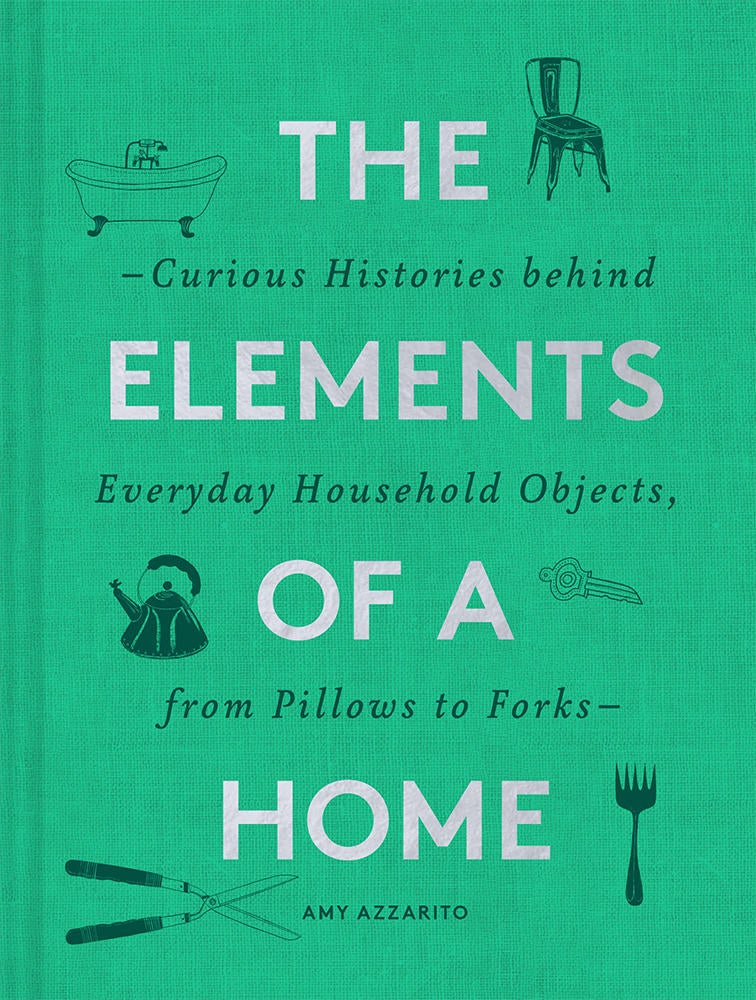Design historian Amy Azzarito always wished that there was a book that compiled the interesting tidbits she spotted in various design tomes. “I would read design history books and come across some fascinating detail about an object that we touch every day,” says Azzarito, whose background includes a stint as the managing editor of Design*Sponge in addition to an eight-year tenure as a librarian. “But they would usually just include a sentence or two, and I always found myself wanting to know more.”
In the absence of a text exploring the histories of items as small as a Champagne coupe or as commonplace as a teapot, Azzarito decided to write one herself. The resulting effort, The Elements of a Home, debuts later this month—and hews closer to a jaunty coffee table book full of fun facts than a stodgy history textbook. Out of the dozens of items chronicled, BOH editors chose five and asked Azzarito to explain the strange and occasionally sordid stories behind the seemingly mundane.

The Fork
While the modern world takes the utilitarian fork for granted, it is, in fact, a relatively new utensil. For many centuries, the fork (shortened from pitchfork) was considered an immoral tool of the devil. “I think it’s easy to see how, in a hyper-religious society, you would look at this two- or three-pronged object and find it offensive,” says Azzarito. People mostly ate with their hands or made do with a spoon until the 15th century, when candied fruits became a craze among Italian aristocrats. “The reason why we use a fork today is because the high society at the time had a sweet tooth and they didn't want their hands to be sticky,” she explains. When Italian noblewoman Catherine de' Medici married the future King Henry II of France, she brought the fork with her, popularizing it in France. (In nearby England, however, Queen Elizabeth I declared “spearing an uncouth action.”)
It took a full eight centuries from the first recorded mention of the fork for it to become routinely used in polite society. “Once it was accepted, no one embraced the utensil with quite so much exuberance as the Victorians,” Azzarito writes in the book. “There was one designed for nearly every type of food: forks for eating lobster, forks for dipping strawberries in whipped cream, and forks for passing bread at the table.”
The Rocking Chair
Created in the eighteenth century, the rocking chair was a mashup of the chair and the cradle, created by colonial settlers in North America with nursing mothers in mind. Despite originally being intended for nurseries, the chair caught on quickly in the new country and was soon a staple of the American home. “The colonial residents in America were often making their own furniture and they had limited resources and couldn’t afford to make the type of heavy chairs that were popular in Europe,” says Azzarito. Visitors from Europe found the chairs so strange that there are many references to them in journals and letters from the time. “Even when seated, Americans push themselves to and fro in their rocking chairs,” wrote a Swiss theologian in 1854. “They live in a state of perpetual excitement in their business, their politics and their religion.”
The Jib Door
“There’s something so magical about the idea of a hidden door,” says Azzarito. Inspired by a tour of Marie Antoinette’s private quarters at Versailles, Azzarito dug into the history of the jib door—a door completely flush with the wall, without any moldings or hinges and often designed to blend in entirely with the surrounding walls. In addition to offering the royal family a place away from prying eyes at Versailles, jib doors were used in grand British houses, where they were often placed on landings in order to give the household staff a place to dash into should a member of the family unexpectedly come up the stairs at the same time. Americans have probably seen the jib doors that are used throughout the White House, most notably in the Oval Office. “They’re rare nowadays,” says Azzarito. “So, when you come across one, it’s just so cool.”
The Monogram
Like so many commonplace items, we have royalty to thank for the ubiquity of monograms. The first known monograms were used by Greek and Roman rulers, printed on coins and small tokens. Centuries later, the monogram was a practical way of keeping track of one’s linens and clothing, which were often cleaned together at a village wash house. In addition to her historical influence on the fork, Catherine de' Medici played a significant role in the lore behind the monogram. Her husband infamously had a mistress, Diane de Poitiers, who had an interwoven D and H applied to everything from the bed linens to the carpets. When Henry II died suddenly, de Poitiers was turned out and all of those monogrammed D’s were altered into C’s. “Wouldn’t that have been so satisfying for her?” says Azzarito. “That is one of my favorite stories, partly because Catherine played such a big part in design history. She comes up again and again.”
Wallpaper
“Looking back at history, it just seems like part of human nature to want to decorate,” says Azzarito. Every society, from the ancient Egyptians and Romans to Victorian England and beyond, had a penchant for decorating their walls. While wallpaper now can easily become an extravagant expense, it was originally considered a cheaper alternative for those who couldn’t afford tapestries. It was Louis XI who, in 1481, had his court painter decorate scrolls of paper which could be hung up like roller shades and easily transported if he wanted them taken down or moved to another of his castles, an idea not so dissimilar to the removable wallpaper of today. “The more things change, the more they stay the same,” jokes Azzarito.




























